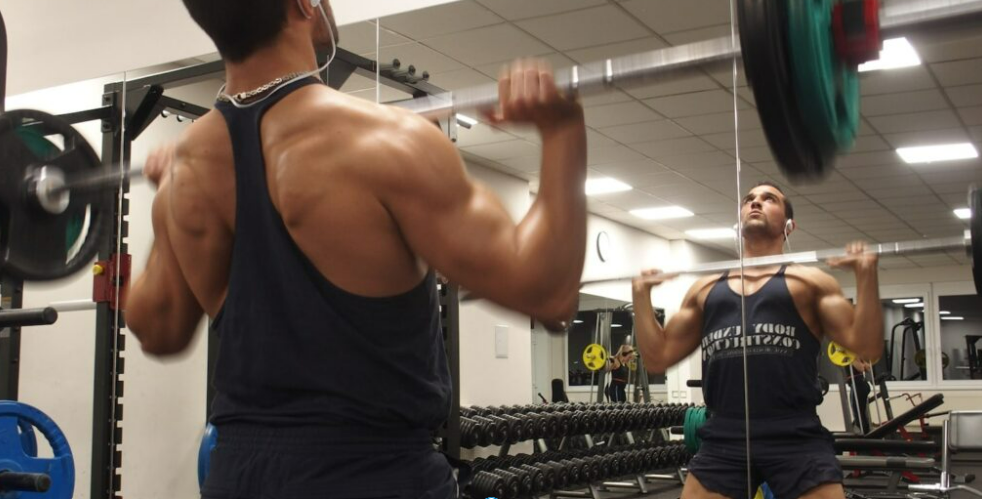Hang Clean Vs. Power Clean: Which Is Better for Athletes?
The power clean starts with the barbell on the ground. The lifter uses their legs, hips, and back to pull the barbell up explosively, catching it in the front rack position, and ideally in a quarter squat. If it’s above parallel, it’s still a power clean, but below turns it into a squat clean. This can be done by lifting all the way from the ground, or from below the knee, or from above the knee. This exercise involves a triple extension of the ankles, knees, and hips to lift the bar. It also has a greater range of motion than the hang clean, and thus trains more of the body than the hang clean does.

The Power Clean
The power clean starts with the barbell on the ground. The lifter uses their legs, hips, and back to pull the barbell up explosively, catching it in the front rack position, and in a quarter squat. This can be done by lifting all the way from the ground, or from below the knee or above the knee position. This exercise involves a triple extension of the ankles, knees, and hips to lift the bar. It also has a greater range of motion than the hang clean, and thus trains more of the body than the hang clean does.
The Hang Clean
The hang clean starts with the lifter holding the barbell at the mid-thigh level. From there, they explosively pull the barbell up to the front rack position. Then, they will drop their body underneath the bar and catch it in a front squat position. The hang clean involves a shorter range of motion than the power clean, as the bar is already elevated. It requires less mobility and flexibility since it starts from a higher position.
While both exercises work similar muscle groups, the hang clean emphasizes the upper body and traps. In this exercise, the lifter must initiate the movement from a static position. The power clean requires more leg drive and explosiveness to lift the bar from the ground.
The Problem With Hang Cleans
With hang cleans, there is a tendency of athletes to “cheat” the lift. This happens when athletes become used to hang cleaning more than doing power cleans from the ground. Instead of maintaining proper, they start to do more of what is known as a “hip clean.”
Hip cleans are where the athlete starts with the bar in the hip crease, or what is known as the “pocket.” Then, the athlete violently thrusts the hips forward to propel the bar’s weight up. When this happens, you’ll often see athletes jump more forward than upward and attempt to dive underneath the bar. If overused, this can cause changes to the full clean performed from the ground.
During this exercise, the arms become massively bent, and the force exerted to lift the bar overutilizes the hips. This takes out the more natural movement pattern of triple extension out of the lift and will train the body to have extremely bent arms before reaching extension. As a result, the bar decreases velocity, and the lift becomes less efficient. For this reason, the Moffitt Method recommends that strength coaches use the hip clean sparingly, if ever. The last thing a strength coach wants to do is reinforce bad technique.
The Solution
To combat this, coaches must focus on teaching proper technique, emphasizing the explosive drive from the legs and hips. This should include starting the pull from the floor with a strong back extension to move the bar quickly off the ground. By using the legs and emphasizing the drive from the legs and hips, the athlete will minimize their arm bend and maximize the amount of weight lifted. They will also finish the lift more effectively.
Hang Clean vs. Power Clean: Which Is Right for Your Athletes?
In short, the power clean from the floor is superior for athletic development in high school and college athletes for two main reasons:
Firstly, the power clean involves more muscle activation throughout the body and is more effective for developing overall strength and power. Since the power clean is performed from the floor, the legs are utilized more, which in turn makes the clean mimic a more natural athletic movement. It also allows the athlete to develop more power and speed.
In the hang clean, the legs are utilized in two separate motions: deadlifting the weight off the floor and moving the bar from the hips to the shoulders. These two separate motions produce less power, but more importantly, the second motion does not as closely mimic more natural athletic movements. It also does not allow full-force production to build over time from the ground to the hips, which would produce more power for the athlete.
The second reason the power clean is preferred is that, in the hang clean, many athletes begin to “hip clean” in an extreme manner. This variation causes the athlete to reinforce bad technique. This in turn results in many athletes skipping the more natural triple extension, which mimics athletic movement.
Are you debating the benefits of the hang clean vs. the power clean, or developing a complete strength and conditioning training program for your athletes? The Moffitt Method can help you create a regimen to help your athletes develop explosive power. We make online strength and conditioning programs for high schools and colleges.
Written by Matt Bruce, 2 two-time Olympic alternate and strength coach for over a decade.